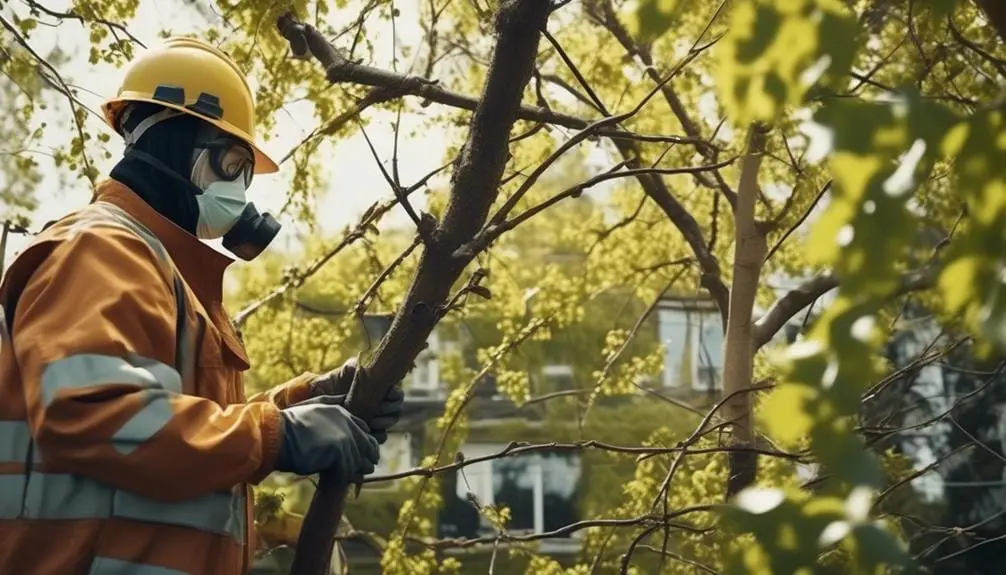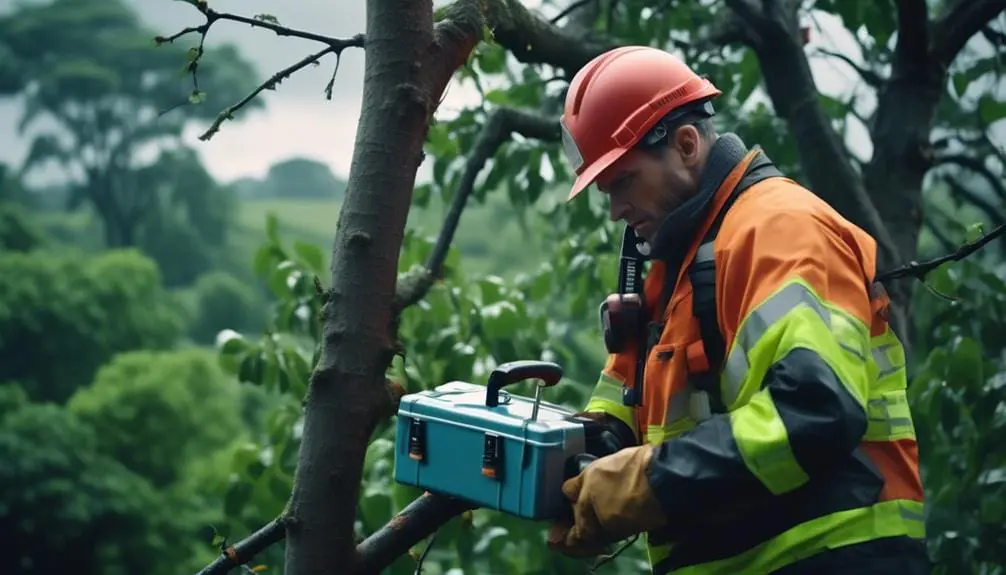Safety and Regulations
Essential Tree Trimming Safety Tips
While the serene beauty of a well-manicured garden stands in stark contrast to the inherent dangers of tree trimming, we can’t ignore the importance of safety in achieving that tranquility.
As professionals in the field, we’ve seen our fair share of close calls and understand that the key to avoiding injury lies in preparation and knowledge.
We’re here to share essential tips that can make all the difference—whether you’re a weekend warrior looking to shape your landscape or a seasoned arborist.
It’s not just about the right tools and techniques; it’s about understanding the risks and knowing how to mitigate them.
So let’s discuss the often-overlooked precautions that could save your limbs or even your life, and explore how staying safe doesn’t have to be a daunting task.
Key Takeaways
- Adhere to established safety protocols, including wearing appropriate protective gear and checking the weather
- Assess potential hazards, such as overhead power lines, and ensure specialized training and equipment are used to avoid contact
- Master safe cutting techniques, including wearing protective equipment and using inspected climbing equipment
- Prepare for emergencies by managing hazards promptly, securing tools, and working with a partner who can take control in emergencies
Understanding Safety Protocols
Adhering to established safety protocols is crucial for minimizing risks while trimming trees, whether we’re professionals or diligent homeowners. We must embrace tree trimming safety tips with the seriousness they demand. Safety is non-negotiable; thus, we immerse ourselves in the learning of tree trimming safety guidelines.
When working near power lines, we’re acutely aware that electrocution can occur without proper precautions. We always wear a hard hat and ensure we’re equipped with a fall protection harness when climbing.
We check the weather before embarking on any project, as high winds and wet conditions aren’t conducive to safe working environments. Wear the right gear, including gloves and protective eyewear, to prevent avoidable injuries.
Our freedom to operate safely is paramount, and we maintain it through rigorous adherence to safety practices.
Selecting Appropriate Protective Gear
Building on our commitment to safety, we now focus on choosing the right protective gear to ensure we’re adequately shielded from the inherent dangers of tree trimming.
To safeguard our freedom to work without injury, we’ve compiled a list of essential items:
- Hard Hat: Protect your head from falling debris.
- Work Boots: Non-slip, sturdy boots to maintain stability and guard your feet.
- Leather Lineman’s Gloves: Shield your hands from cuts and abrasions.
- Face Shield & Comfortable Eye Protection: Prevent facial injuries and keep eyes clear from debris.
- Protection Harness & Climbing Rope: Essential for safe climbing and maneuvering at heights.
Let’s not forget to protect our ears with ear protection such as disposable ear plugs, and ensure leg protection to prevent any mishaps.
Assessing Potential Hazards

Before initiating any tree trimming tasks, it’s crucial to conduct a thorough inspection of both the tree and the surrounding area for potential hazards. We must meticulously inspect the tree for structural integrity and identify any interference from power lines.
Electrical lines, especially overhead power lines, pose significant risks; a downed power line may still be energized. Working near power lines requires extreme caution to prevent contact with a power line, which can be fatal. Additionally, using conductive tools around energized power lines demands specialized training and equipment.
We’ll establish clear zones of operation and ensure constant communication between crew members to avoid accidents. By adhering to these protocols, we’ll maintain a safe environment, allowing us the freedom to perform our work without unnecessary risk.
Mastering Safe Cutting Techniques
To ensure our tree trimming efforts are both effective and secure, we’ll focus on mastering safe cutting techniques that reduce the risk of injury and property damage. As we trim branches, we’re committed to precision and professionalism, employing tactics that honor our audience’s desire for freedom in maintaining their landscapes. Here’s how we can excel:
- Always wear protective equipment, including gloves, goggles, and sturdy boots.
- Keep a safe distance from power lines, using an aerial lift if necessary to avoid shock.
- When using a chainsaw, ensure you’re trained and maintain a firm grip.
- Utilize proper climbing equipment that’s inspected for safety before ascent.
- Be vigilant about the potential for falling branches and alert those below to clear the area.
Preparing for Emergencies

While we equip ourselves with the knowledge of safe cutting techniques, it’s equally crucial to be prepared for any emergencies that may arise during tree trimming activities. We must use extreme caution at all times, ensuring we stay safe.
Pay attention to the work area; hazards can develop rapidly, and the situation can escalate if not managed promptly. Keep tools away from edges where they could fall and cause injury. Use a rope to let a partner pass tools up and down securely.
Always work with a partner who can Take Control if an emergency occurs. By doing so, we maintain our freedom to operate safely, without the constraints of accidents.
Conclusion
In conclusion, we’ve emphasized the utmost importance of adhering to stringent safety protocols when trimming trees. By selecting proper gear, assessing hazards, mastering cutting techniques, and preparing for emergencies, we ensure our well-being and efficiency on the job.
Let’s continuously refine our practices, stay vigilant, and abide by these guidelines to safeguard against accidents. Our professional commitment to safety is non-negotiable; it’s the cornerstone of exemplary tree trimming operations.

Hello there! I’m Logan Foster, the green-thumbed social media marketer behind the vibrant world of 1800TreeGuy.com. With roots firmly planted in arboriculture, I’ve branched out to help clients cultivate their dream outdoor spaces, one leafy canopy at a time. My knack for nurturing nature is more than a profession—it’s a way of life.
When I’m not talking trees and teaching the art of arboreal care, you can find me cheering on the Bulldogs—my alma mater’s pride and my forever team. My environmental studies there didn’t just teach me about ecosystems; they instilled a lifelong passion for protecting our planet.
Off the clock, I’m an adventurer at heart. Whether it’s trekking the Appalachian trails, pedaling down a mountain path, or crafting guides to share the wonders of the wild, I’m happiest with soil under my nails and the sun on my face. And let’s not forget Yoda, my pug sidekick. He may not have mastered the art of stillness, but his joyful grins are my daily dose of happiness.
I’m all about making connections—between people and the great outdoors and between my clients and their ideal landscape visions. My approach is personal; every tree has a story, and every garden reflects its caretaker.
If you want to green your scene or share in my outdoor escapades, give me a shout on Instagram or Facebook. Let’s cultivate a conversation and grow a community rooted in a love for the lush life.







